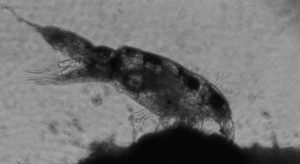A decision support system for sea lice management in salmon aquaculture

Lead PI: Kelly Cole
PI Email: kelly.cole@maine.edu
Co-PI: Ian Bricknell, Mike Pietrak & Damian Brady
Project Team:Ellie Ghlan
Abstract: Over 90% of Maine aquaculture landed value comes from farmed Atlantic Salmon. One of the more limiting and potentially environmentally destructive factors associated with salmon aquaculture in Maine is salmon, or sea lice (Lepeophtheirus salmonis (Krøyer 1837)). Sea lice are a parasite that attach and feed on a host’s epidermal tissues, causing osmotic regulating problems and susceptibility to infections (Asplin et al. 2014). They are an obligate ectoparasite on salmonid hosts and occasionally on other fish. They are the most significant pathogen facing the salmon aquaculture industry today and susceptibility to disease is exacerbated when fish are caged in dense numbers. Processes in the physical environment, such as wind, fresh water and tidally forced currents mix, disperse and accumulate sea lice throughout the coastal ocean, increasing susceptibility of infection in farmed and wild fish. For this reason, the ocean environment is important for growers in a successful industry to model. The economic costs associated with sea lice management are significant and as resistance to many of the available drug treatments increases, farmers are more reliant on a mix of drug and non-drug management strategies to minimize costs. To effectively manage lice, farmers need to consider a variety of environmental information that is not readily available. At its core, lice prevalence is a marine science problem that can be mitigated using oceanographic tools to predict the ocean state. Though validated hydrodynamic models exist in the Gulf of Maine and are currently being applied to various ocean problems, ranging from energy capture to shellfish aquaculture, a tool for decision making by the salmon farmer does not yet exist. Managers currently decide treatment strategies based on personal experience, information from informal sources, and qualitative knowledge of variable ocean circulation and environmental conditions. These underinformed decisions can result in avoidable spread of lice between farms. The long-term goal of this project is to implement a Decision Support System (DSS) to regulate the spread of sea lice by helping growers decide 1) when and in what order to treat existing farms and 2) where to site future farms. This tool will increase the scientific basis for decision making in the industry. The DSS will be available on the web and have several key components, including a collection of stakeholder-developed-and-approved lice dispersion metrics illustrated from grower-driven experiments using numerical ocean models and a farmer-friendly, interactive, click-and-release lice tracking tool within the animated farmer-driven experiments. It is hypothesized that lice counts at farms, and connectivity, i.e. how larvae get transported between neighboring farms, can be accurately modeled and ultimately mitigated by working with farmers to develop and release a coupled physical-biological model, specifically integrating sea lice behaviors related to temperature, current speeds and salinity gradients with tide, wind and river induced circulation. This physical-biological coupled numerical approach has been extremely successful in growing areas around the world (e.g. Murray and Gillibrand (2006), Amundrud and Murray (2009) and others), and the foundation to begin building this modeling infrastructure on the Maine coast has recently come into existence; both scientists and stakeholders alike are excited about the positive impact it will have in the salmon industry. The overall objective of this project is to integrate information on sea lice development, circulation and hydrography, potential transport of sea lice, and management strategies into a single user-friendly system that helps farmers make strategic siting and treatment decisions. We aim to improve the efficiency and decrease the expense of sea lice treatments for farmers through solutions-oriented research. Ultimately, we envision this effort as an industry-research connection that will allow salmon farmers to explore the potential provenance of sea lice infection and connectedness of sites
Project Dates: June 1st, 2020 – March 31st, 2023
Project Funding: Kelly Cole, Ian Bricknell Damian Brady Mike Pietrakg

